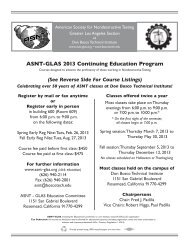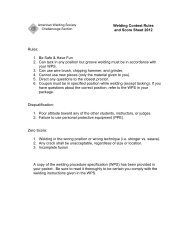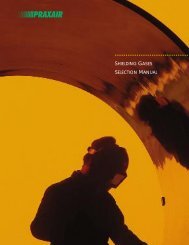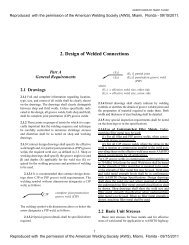WELDING AND ALLIED PROCESSES
SFLC Std Spec 0740 - U.S. Coast Guard
SFLC Std Spec 0740 - U.S. Coast Guard
Create successful ePaper yourself
Turn your PDF publications into a flip-book with our unique Google optimized e-Paper software.
SFLC ST<strong>AND</strong>ARD SPECIFICATION 07403.4 Filler material restrictions. The Contractor shall be aware that low ductility shielded metal arcwelding electrodes, including AWS classification E6010, E6012, E6013, E7014 and E7024, are notapproved for joints in critical welds (see 1.3.5 (Critical welds)).3.5 Temperature-indicating crayons. The Contractor shall not use temperature crayons that containelements such as lead, sulfur, zinc, cadmium, or mercury.3.6 Process restrictions. The Contractor shall not use gas metal-arc welding (GMAW) utilizing shortcircuiting arc transfer technique (the consumable electrode is deposited during repeated short circuits) forwelds in ship structure above 0.25-inch material thickness, unless the process and application arespecifically approved by the Contracting Officer.3.7 Surface preparation. Contractor shall clean to bare metal all surfaces out to one inch on both sides ofthe weld joint to remove all foreign materials, unless otherwise directed by the work item or appendix.Scale and metallic oxides shall be removed from surfaces on which weld metal is to be deposited.3.8 Nondestructive inspection (NDI). When inspecting welds using visual inspection (VT), liquidpenetrant inspection (PT), and magnetic particle inspection (MT); the Contractor shall ensure that theweld surface shall be clearly visible, i.e. free of paint, grease, etc. Inspection shall be in the final surfacecondition. Inspection of repairs to base materials or welds shall be to the same requirements as theoriginal base material or weld.3.9 Surface preservation. The Contractor shall prepare and coat all new and disturbed exterior andinterior surfaces to match existing adjacent surfaces, in accordance with COMDTINST M10360.3,Appendix A (Cutter and Boat Exterior Paint Systems) and Appendix B (Cutter and Boat Interior PaintSystems).3.10 Repair of holes. The Contractor may repair holes by welding closed, provided the original holediameter does not exceed 2-1/2 inches and the material thickness is 1/4 inch or greater. Holes 1/2 inch orless in diameter shall be opened to greater than 1/2 inch diameter. The opening shall be shaped to 20degrees minimum included angle before welding. Holes greater than 2-1/2 inches original diameter shallbe repaired by expanding the hole size for an insert.3.11 Zinc coatings. The Contractor shall remove metallic zinc from all joint surfaces on which welds areto be deposited and for a distance which will be at least 1 inch from the edges of the finished welds. Thelocalized heating technique shall not be used for removing zinc coatings from HY-80/100/130, STS orsimilar chemistry, or quenched and tempered low alloy high strength materials.3.12 Requirements for High Yield (HY) materials HY-80, HY-100, HY-130 and high-hardenablematerials. The Contractor shall not use oxyfuel gas gouging for HY-80, HY-100, HY-130, and highhardenablematerials. Torch heating for HY-80, HY-100, HY-130, and high-hardenable material shall beconfined to tack or temporary welding or to those applications involving welding within a localized area.When torch heating is used for welding operations other than for tack welding, the base material shallslowly be brought up to preheat temperature with sufficient time allowed for heat to penetrate thethickness of the parts being welded. The heated area should extend approximately 6 inches beyond theweld site directions. When torches are used for low temperature (60°F to 125°F) preheating, maintainmetal temperature above ambient temperature for a few minutes before welding in order to minimizecondensate caused by the flame.3.13 Cut edges. The Contractor shall ensure that cut edges of plate do not have gouges or irregularitiesJan 2009 6 0740







